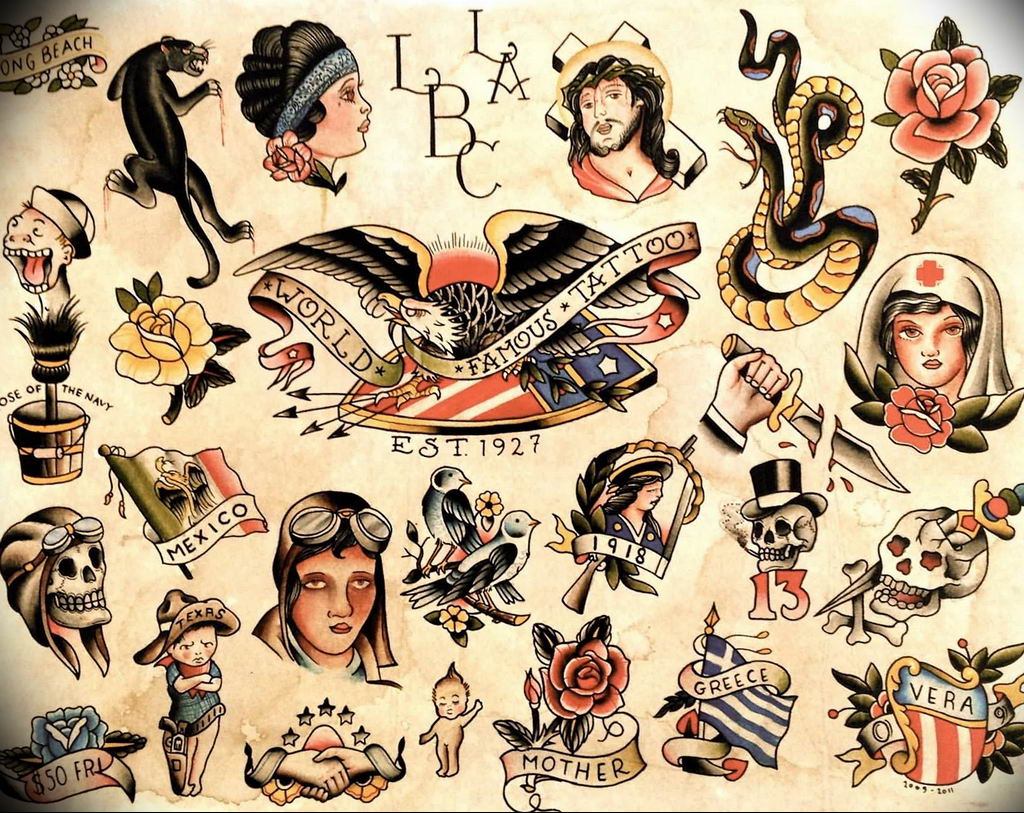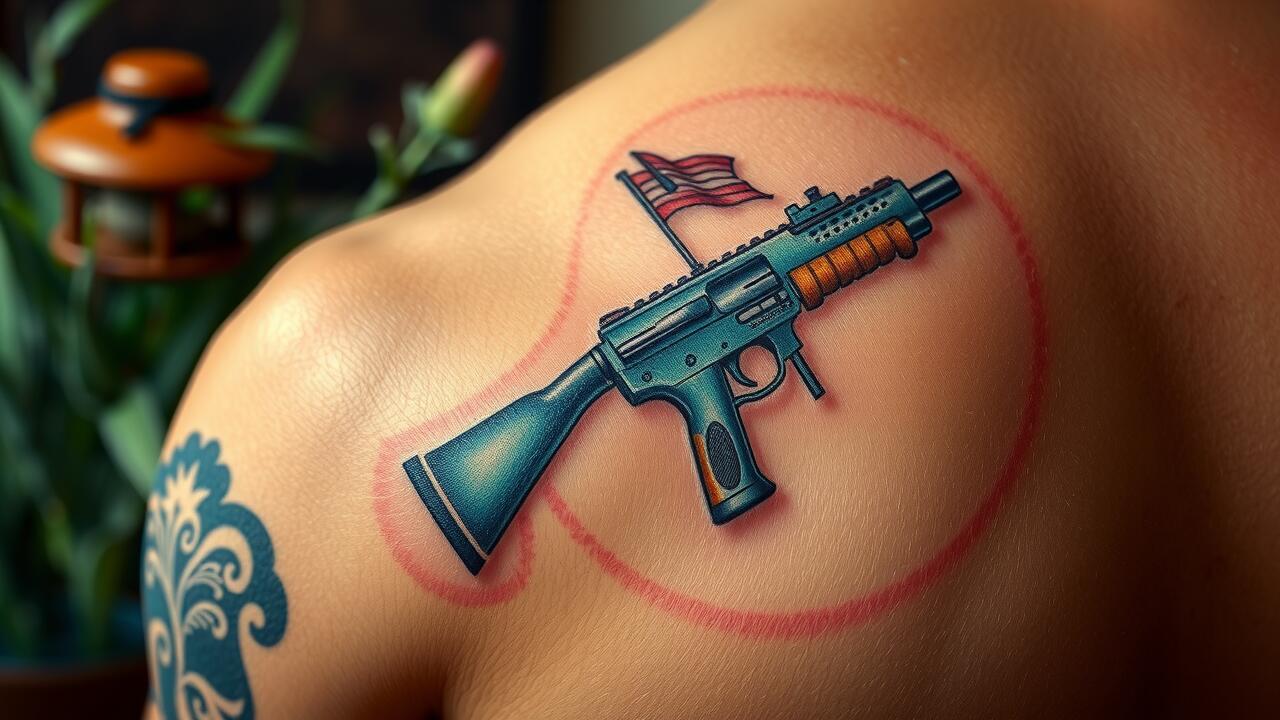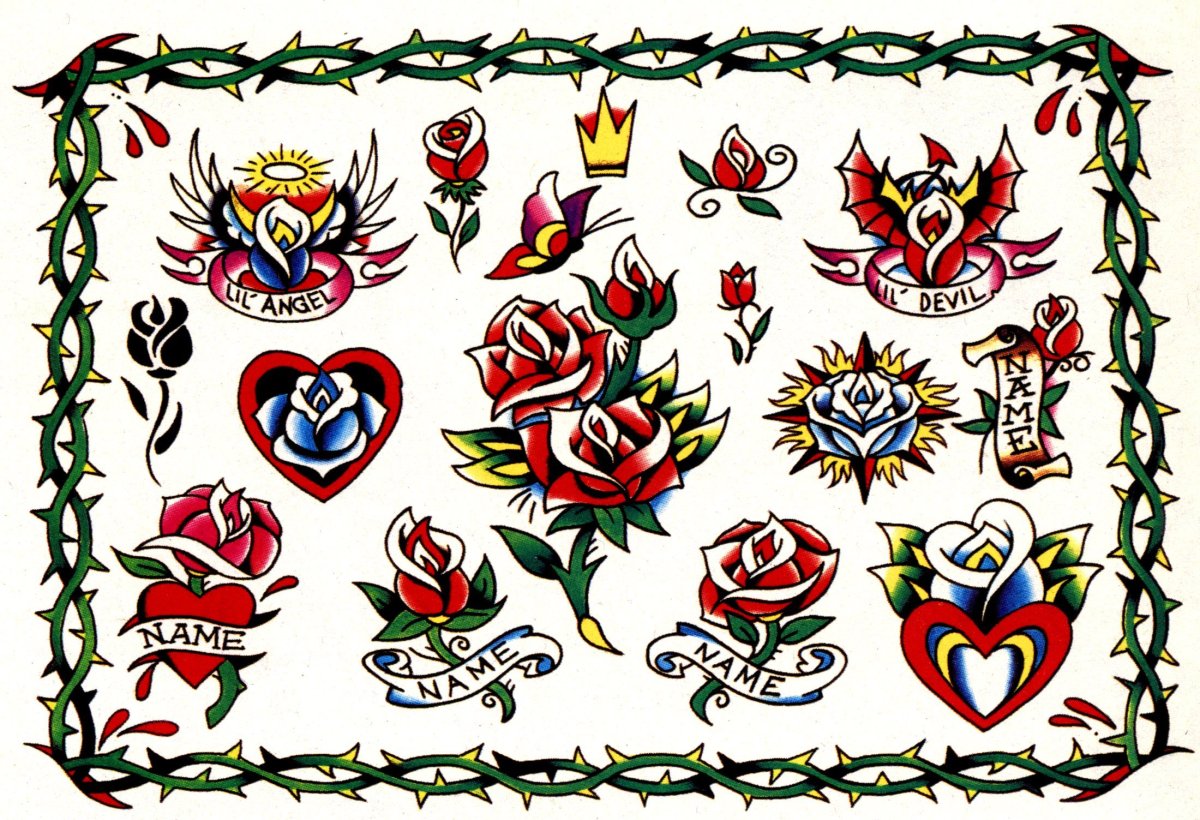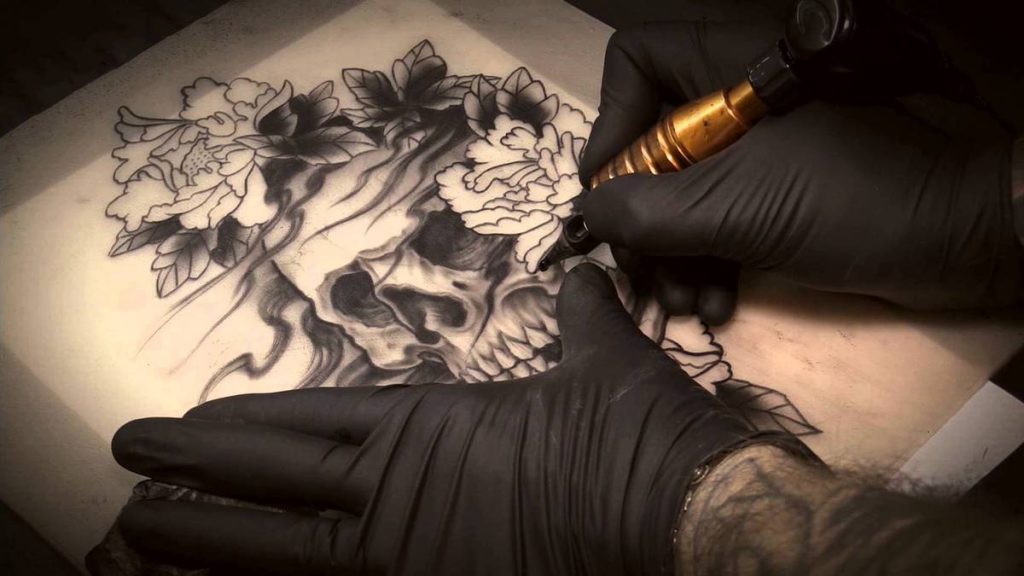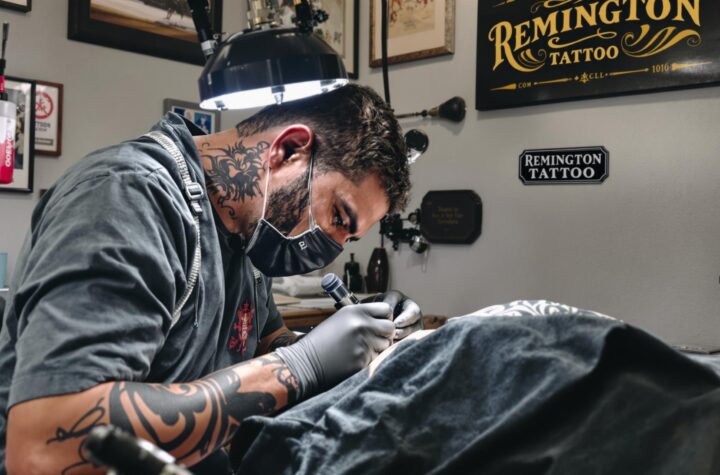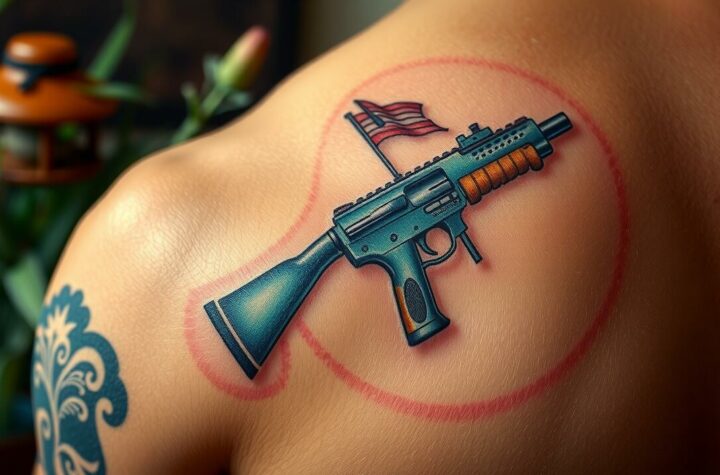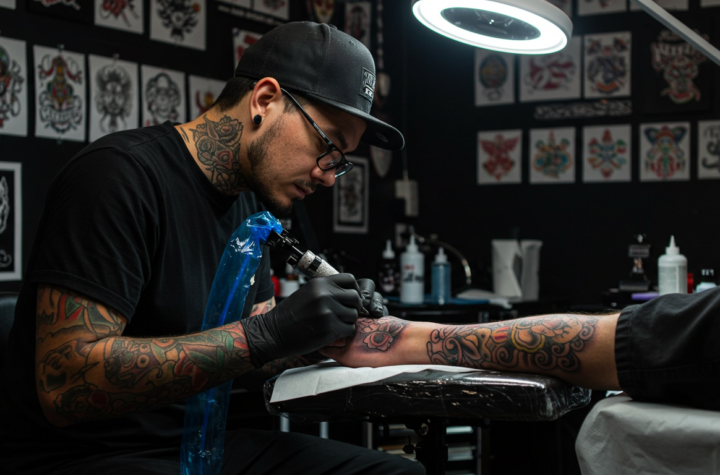The History of American Traditional Tattoos
The enigmatic legacy of American traditional tattoos stretches far back into the annals of tattoo history, harking to a time when inked artistry first took root in America. A mesmerizing tapestry of narratives unravels before us, tracing its origins to the twilight years of the 19th century and early decades of the 20th century, an era that witnessed sailors embracing this captivating form of self-expression. These intrepid seafarers would etch their skin with indelible souvenirs from their voyages or emblems symbolizing their maritime exploits. Anchors, ships, and enchanting mermaids danced upon these fleshly canvases, forging an iconic style steeped in nautical motifs.
Immersed within this storied tradition lies one luminary figure whose artistic prowess sculpted the contours of American traditional tattoos: Sailor Jerry Collins. Born as Norman Keith Collins, his masterful hand crafted striking designs that reverberate even today with echoes drawn from Japanese tattoo art entwined harmoniously with his own idiosyncratic sensibilities. The alchemy birthed bold and resplendent creations deemed venerable icons by aficionados across generations.
Yet there is more than meets the eye adorning these vivid pigments on human skin; they transcend mere decorative impressions. They become conduits for personal expression while simultaneously serving as mirrors reflecting identity and belonging within tightly-knit communities. For countless individuals seeking solace in body artistry, acquiring an American traditional tattoo stands as a rite of passage or a tribute paid to ancestral heritage and cherished values. This captivating genre has woven itself irrevocably into the very fabric comprising tattoo culture at large—inspiring both artists who wield needles like brushes and enthusiasts who marvel at their craft.
Over epochs past, we witness how American traditional tattoo designs have undergone metamorphosis under diverse influences that shape-shift through time’s relentless march. From humble beginnings etched onto the flesh of sailors, this genre has transcended its maritime roots to encompass a vivid tapestry of subjects. Animals, flowers, patriotic symbols—a kaleidoscope of motifs—now populate its ever-expanding repertoire. Countless variations breathe new life into the classic American traditional aesthetic while steadfastly retaining its timeless allure.
As we plunge headlong into the labyrinthine corridors chronicling the annals of American traditional tattoos, their inked narratives reveal themselves as more than mere skin-deep impressions; they embody an enigmatic union between artistic expression and cultural significance—an alchemic fusion that continues to mesmerize individuals across continents. Whether one is enraptured by their bold strokes or captivated by their historical context, one cannot deny the indomitable power and magnetic pull emanating from this eternal tattoo style. So when you next venture forth into a sanctuary of artistry housed within a tattoo parlor’s walls, dare to explore the captivating realm awaiting your discovery—the realm where American traditional tattoos thrive—and uncover for yourself the boundless depths of skillful craftmanship contained therein.
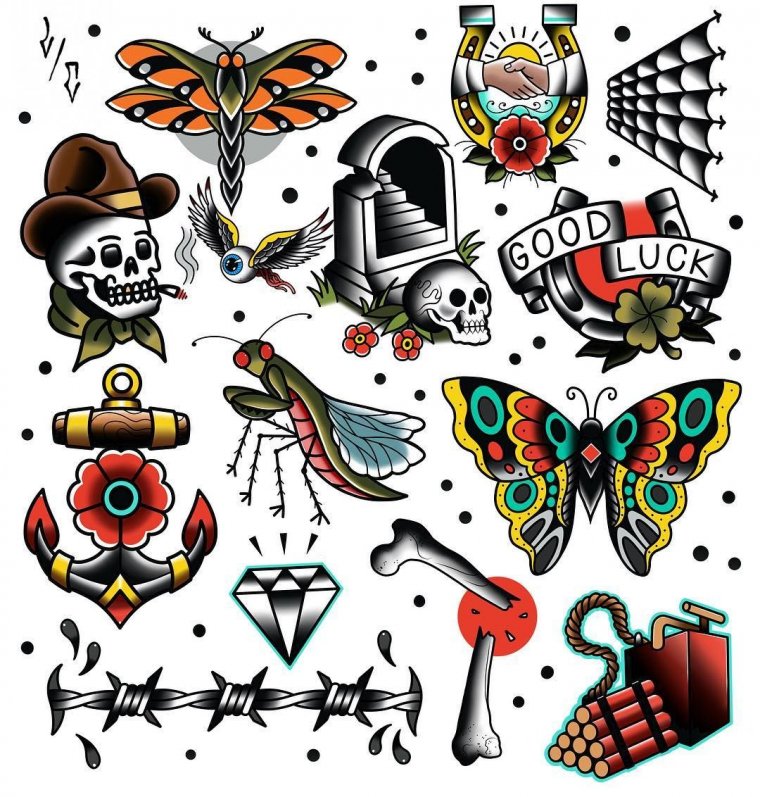
The Influence of Sailor Jerry on American Traditional Tattoos
Norman Keith Collins, better known as Sailor Jerry, emerged as a perplexing and bursty force within the realm of American traditional tattoos. His indelible mark on this art form cannot be overstated, for he not only played a pivotal role in its evolution but also garnered immense popularity.
The enigmatic allure of Sailor Jerry’s work captivated traditional tattoo artists who sought to emulate his audacious strokes, striking hues, and emblematic motifs such as majestic eagles, steadfast anchors, and alluring pin-up girls.
With his vintage techniques and idiosyncratic artistic flair, Sailor Jerry left an enduring imprint upon the cultural heritage of American traditional tattoos. This cryptic craftsman’s contributions can be traced back to the early 20th century when he embarked on an odyssey of design experimentation while honing his craft to perfection. Armed with archaic hand-built tattoo machines that were commonplace at the time, Sailor Jerry fashioned intricate masterpieces that showcased both his profound acumen and boundless inventiveness.
Sailor Jerry’s influence transcended geographical boundaries; it traversed oceans and permeated foreign lands where traditional tattoos hold paramount significance. Notably impacted by encounters with Japanese tattoo masters during his globe-trotting adventures, Sailor Jerry engendered a captivating amalgamation between American traditional artistry and elements borrowed from Japan’s venerable artistic traditions.
The labyrinthine tale behind Sailor Jerry’s oeuvre continues to bewilder contemporary tattoo artists today. His legacy stands tall as an inspiration not only for aesthetic pursuits but also for fostering a vibrant global culture surrounding body ink adornment. The cultural import of American traditional tattoos extends far beyond mere embellishment; they serve as spellbinding visual chronicles that encapsulate personal narratives or symbols deeply entrenched in age-old customs and individual identities.
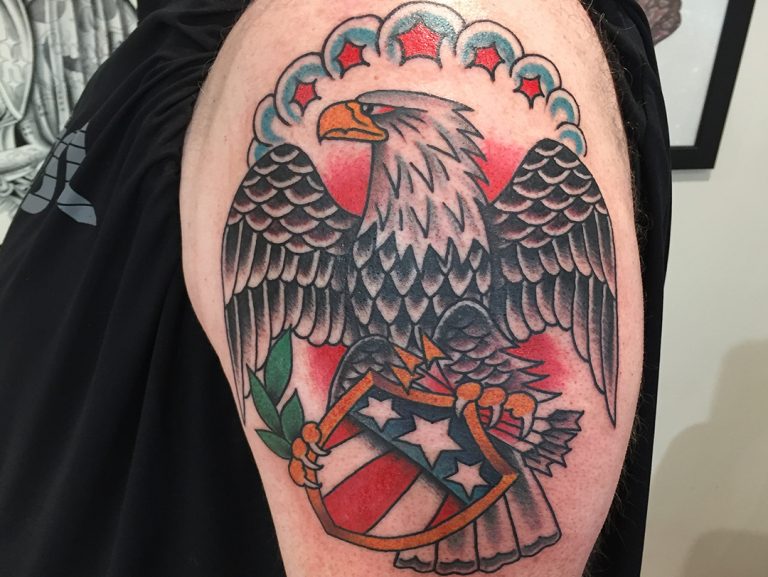
The Cultural Significance of American Traditional Tattoos
The enigmatic world of American traditional tattoos envelops a history shrouded in the mists of time, spanning across centuries. In the vast expanse of North America, Native American tribes were among the pioneers of body art, adorning their flesh with ethereal designs crafted from nature’s bounty—bone and plant dyes intricately etched onto their skin. These masterpieces bore profound cultural symbols and served as conduits to spiritual beliefs.
As epochs unfolded, tattooing underwent metamorphosis, birthing new styles and techniques. Yet amid this kaleidoscope of evolution, American traditional tattoos endured as an ardent choice for enthusiasts yearning to embrace its indelible allure. Characterized by audacious lines that defy conformity, hues so vibrant they ignite souls, and imagery steeped in iconicity like majestic eagles or steadfast anchors—the timeless tradition lives on. Tattoo studios scattered throughout the nation reverently uphold this classic style while seamlessly interweaving contemporary elements into their tapestry.
Within each individual lies a distinct interpretation of meaning; yet collectively within society at large dwells a cultural significance that transcends mere aesthetics. Traditional tattoos stand as visual footprints etching personal stories or experiences upon human canvases—a form of self-expression pulsating with life force unparalleled. Moreover, these artistic wonders bear witness to fostering identity and belonging within tight-knit communities—an unseen tether binding souls together.
Thusly unfolds the grand tapestry where the cultural significance weaved into every fiber unravels beyond surface beauty—it intertwines itself irrevocably with tattooing’s own storied past. From ancestral traditions imbued with ancient wisdoms to modern interpretations alive with contemporary resonance—this timeless embodiment continues captivating denizens across our mesmerizing globe today.
Traditional Tattooing: A Brief History
Tattooing, a practice with an enigmatic and unpredictable past, stretches back through the annals of time. A captivating tale unfolds as we delve into the late 19th century in the United States, where tattoo artists began to fashion their own distinctive style: American Traditional Tattoos. This art form drew inspiration from illustrious tattoo traditions found in Japan and India while also incorporating motifs borrowed from indigenous tribes scattered across the globe.
In this era of exploration and discovery, countless young American men embarked on transformative journeys abroad, forever etching these experiences onto their skin as indelible mementos. These inaugural tattoos often showcased timeless designs like anchors, regal eagles, and maritime symbols that captivated seafarers far and wide. The aesthetic of tattooing itself underwent a mesmerizing metamorphosis during this epoch as audacious lines intermingled with vibrant bursts of color on living canvases.
A pivotal figure who left an indelible mark on American Traditional Tattoos was none other than Sailor Jerry Collins. Nestled amidst Hawaii’s archipelago during World War II, Collins skillfully assimilated elements from Maori tattoos into his oeuvre while simultaneously popularizing iconic designs such as pin-up sirens and swift swallows. To this day, his artistic legacy continues to ignite inspiration within contemporary tattoo artists.
American Traditional Tattoos serve not only as expressions of individuality but also embody profound cultural significance. They act as visual narratives encapsulating personal stories while concurrently linking individuals to grand historical tapestries. Originating within maritime culture before embracing diverse influences hailing from every corner of our planet Earth, traditional tattooing has transformed into an enduring art form that authentically captures America’s multicultural essence.
The allure for traditional tattoos flourishes unabatedly over time; both men and women now wholeheartedly embrace this ageless expression for myriad reasons – some seeking avenues for self-revelation or paying homage to ancestral heritage, while others simply revel in the captivating aesthetics or yearn for a perpetual reminder of something deeply meaningful in their lives. With a lineage steeped in history and an intricate web connecting global cultures, it is no wonder that American Traditional Tattooing remains an adored tradition cherished by countless individuals across generations.
The Evolution of American Traditional Tattoo Designs
Throughout the annals of human history, tattoos have perplexed and intrigued scholars, their existence shrouded in an enigmatic aura. Stretching back thousands of years, these indelible marks bear witness to a diverse tapestry of cultures that adorned themselves with ink for myriad purposes. Native American tribes wove intricate tales upon their skin, utilizing tattoos as a medium for storytelling and cultural expression. Similarly, the traditional Japanese art form imbued deep symbolism within its designs, intertwining spirituality and body adornment.
A burst of transformation emerged in the late 19th century when western society experienced a seismic shift towards embracing tattooing. The catalyst for this revolution was none other than the advent of the electric tattoo machine – an invention that forever altered the landscape of inked artistry. Suddenly accessible to all who sought it, this technological marvel ignited an explosion in popularity among sailors and soldiers alike. These intrepid souls etched permanent souvenirs onto their flesh during voyages or forged enduring symbols of camaraderie.
Yet woven amidst this tapestry of evolving acceptance lurked shadows cast by organized crime’s embrace of tattoos during that era. Gang members and criminals adopted these indelible markings as emblems marking allegiance to illicit enterprises. Such negative connotations tainted mainstream perception until redemption arrived on Sailor Jerry’s skillful hands at mid-20th century’s cusp. This artistic luminary breathed life into traditional designs once more through his flash artwork inspired by cultures worldwide – most notably Hawaiian “kakau” symbols pulsating with rich cultural significance.
Today’s American traditional tattoo designs continue to metamorphose while remaining steadfastly rooted in historical legacy and ancestral customs. Bold lines traverse flesh like ancient runes etched upon parchment; limited color palettes blend seamlessly with iconic imagery such as anchors or resplendent roses blooming defiantly against time’s relentless march forward. Society has gradually extended open arms towards these vibrant expressions adorning human canvases, recognizing their aesthetic allure and profound ability to encapsulate personal narratives or commemorate life’s significant milestones. Deeply embedded within the cultural fabric of our collective history, American traditional tattoos transcend mere ink on skin – they become a tangible reflection of our shared human experience and individual identities.
What is the enigmatic history that lies behind American Traditional tattoos?
The perplexing origins of American Traditional tattoos stretch back to the depths of the early 19th century. These captivating tattoos first gained popularity among sailors, entrancing onlookers with their burstiness of bold lines, a limited color palette that tantalized the senses, and an array of iconic designs.
Who were the mysterious influencers who shaped the development of American Traditional tattoos?
One cannot unravel the intricate tapestry woven by Sailor Jerry, also known as Norman Collins, when it comes to influencing American Traditional tattoo artistry. This enigmatic figure’s ingenious style blended seamlessly with Asian and Polynesian tattoo techniques, leaving an indelible mark on shaping these mesmerizing designs.
What secrets lie within the cultural significance of American Traditional tattoos?
The allure surrounding American Traditional tattoos exudes immense cultural significance as they transcended mere ink on skin to become emblems symbolizing identity, loyalty, and pride for varied groups. These captivating works often served as powerful representations of military service, patriotism, and a profound sense of belonging within specific communities or professions.
How has traditional tattooing undergone its own bewildering metamorphosis over time?
Through an enigmatic dance alongside advancements in tattoo technology and shifting societal norms swayed by various art movements’ tempestuous winds. This evolution embraces vibrant new color palettes that ignite excitement within observers’ souls along with more intricate designs that bewilder even trained eyes. Furthermore, traditional tattooing has expanded beyond conventional boundaries to encompass a broader range of subject matters that elicit both awe and curiosity.
What hidden treasures reside within common elements found in American Traditional tattoo designs?
The mystique encapsulated in each stroke reveals itself through audacious lines commanding attention at every glance while solid colors pulsate with vibrancy akin to bursting fireworks illuminating night skies. Iconic imagery such as anchors, roses, eagles, and nautical symbols become talismans of this captivating art form. These elements possess an enduring allure that continues to captivate admirers even in the present day.

